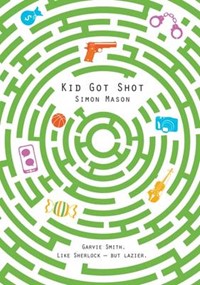Simon Mason


About Author
Simon Mason's young adult novel Moon Pie was shortlisted for the Guardian Children's Fiction prize, and his first book in The Quigleys series was highly commended for the Branford Boase Award.
The first Garvie Smith Mystery, Running Girl, was shortlisted for the Costa Children's Book Award, and Kid Got Shot won the CrimeFest Best Crime Novel for Young Adults award. As well as writing, Simon also works in children's publishing, having edited books including Philip Pullman's Daemon Voices.
Simon lives in Oxford with his wife and their two children.
Interview
HEY, SHERLOCK (THE GARVIE SMITH MYSTERIES)
DAVID FICKLING BOOKS
NOVEMBER 2019
HEY, SHERLOCK is the latest book in The Garvie Smith series by SIMON MASON, compelling detective stories that follow the bright but unassuming teenager, Garvie, as he helps solve local mysteries alongside the rather hapless police detective DI Singh.
Our ReadingZone reviewer writes, 'This is a fantastic trilogy of books that really revitalises the mystery/detective fiction genre for young people. I would highly recommend these books to children over the age of 14.'
We asked author SIMON MASON to tell us more about how the series began and his latest book, HEY, SHERLOCK:
Q: The Garvie Smith books are a murder-mystery series. What took you in this direction with your writing and what do you enjoy about writing for older readers?
A: I've always admired the addictive storytelling of the great crime writers - the ancient art of literary hypnosis, as practised by Homer and Stephen King alike. We are storytelling animals - we live by stories. For us, the seduction of a story's mystery is deep and powerful; we have to find out what happened. Our curiosity drives us wild until it is satisfied. And, as a species, we are deeply interested in wrong-doing. The criminal is a figure of appalled fascination. The detective too.
For all these reasons I wanted to have a go at a murder mystery. Why for teenagers? Because I am a member of The Teenagers Survivors Club. Of all the astonishing things in the world - the 2012 Olympics, Triple Heart Bypass, the Chrysler Building, Trump - teenagers are the most astonishing. Human exploding devices bursting out into the world in great starbursts of attitude and inventiveness and fantasy and humour. I wanted to both write about them and write for them.
Q: Who are your favourite murder mystery writers?
A: Conan Doyle, creator of Sherlock Homes. Sherlock sees the signal in the noise, the detail everyone else misses. He keeps things to himself, goes at them his own way. He cares about justice, but couldn't care less about the law; if it helps to solve a problem he doesn't mind a bit of breaking and entering, cheeking the police, etc.
Agatha Christie, creator of Hercule Poirot. The egg-head Belgian - himself a whole mass of neuroses, understands the way people behave; he's empathetic.
Raymond Chandler, creator of Philip Marlowe. Marlowe's a cynic on the outside, a purist on the inside. He has a conscience and a tenderness - but likes to keep both well hidden.
When I first thought of Garvie Smith, I wanted him to have a little bit of each of these key characteristics.
Q: There are three books in the Garvie Smith series so far - can you tell us a bit about the story arc in Running Girl, Kid Got Shot and Hey, Sherlock?
A: At the beginning of Running Girl, 16-year-old Garvie Smith is bored. Disaffected. Nothing gets his attention. Then the body of his ex-girlfriend Chloe is pulled from Pike Pond. He's meant to be revising for his exams but he'd rather interfere with the official police investigation into Chloe's death. This doesn't appeal to the police investigator, Raminder Singh, an upright - and uptight - Sikh detective, a stickler for rules and regulations. But they become an unlikely pair - not exactly a team - engaged (in very different) ways on the same task.
Running Girl ends with Garvie solving the crime but missing his first exam. Kid Got Shot begins with him missing others. Time to focus on schoolwork? Unfortunately, the body of a boy from Garvie's school is found in a warehouse on an industrial estate. A nice polite Polish boy who had never been in any sort of trouble. So why was he involved in a shootout in the middle of the night? As before, Garvie can't help getting involved, enlisting his reprobate friends Alex, Felix and Smudge to help him with a bit of breaking and entering and strong-arm stuff. His mother - also as before - despairs of him as exam dates begin to whizz by unrequited, and begins to think that Raminder Singh might be her friend rather than an enemy.
Kid Got Shot ends, once more, with success in crime-solving and failure in exams-taking. Hey, Sherlock! finds Garvie having, by necessity, left school. He's been taken on, with his friend Smudge, in Smudge's brother's fencing business. It's Garvie's entry into the world of work, all early-morning starts and hoisting fence panels - and he's not so keen. Then the daughter of the woman living in the big house where they are working goes missing, taking with her the family guard dog, later found dead in the woods. Singh is unnerved, when called out, to find Garvie already on the scene - but this time he's smart enough to tolerate, even encourage, Garvie's involvement. And Garvie, for the first time, begins to think that Singh might not be too bad a cop.
Each book is a self-contained criminal investigation. But across the three, the relationships between the characters develop, sometimes in unexpected ways. Garvie himself changes; he begins to grow up.
Q: What's the biggest challenge in writing a murder mystery story?
A: There are three, I think. Firstly and most importantly, plotting a convincing and gripping story. Secondly, creating a charismatic central character. Thirdly, presenting a vivid location. Anyway, these were the three goals I set myself.
Q: How many drafts do you go through for each of your Garvie Smith books? Who checks all the clues line up?
A: I spend a year thinking things through, telling myself the story in my head. During this phase, it goes through many changes: characters come and go, the story swirls unpredictably, clues flutter about like confetti. Usually, there's at least one minor character who gate-crashes the story - hogging the good lines, showing up in chapters he has no right to be in, and refusing to leave. Then I spend about six months composing the first draft, sticking pretty closely to what I imagined. Then I take that first draft to my editors, and we kick it around a good deal. And finally, I spend about four months writing a second draft. My wife tactfully points out any unsatisfactory passages. My children rudely rip into it, gleefully highlighting dad-stupidities and providing helpful and amazingly expert comments on consumer goods, current fashions and so on.
Q: Garvie Smith, your lead character, isn't an easy person - how did his character develop and what is his appeal to you?
A: Garvie Smith is 16 years old, super-bright - photographic memory, dazzling powers of logical deduction, the whole bit - and phenomenally lazy. He's getting into bad habits: truanting from school, lying to his long-suffering mother, smoking weed, clashing with the police. The world hasn't done anything for him, why should he do anything for the world? Fair enough. Such boys are very well-represented in life but less so in literature. I wanted to put him in a book. Personally, I'm a mild, cautious, conforming type. Why I'm drawn to the badly behaved Garvie is a matter for a psychoanalyst.
Q: What are the advantages and difficulties in getting a young person involved in the mystery?
A: To be honest, I rarely think in those terms. Perhaps I should. But I don't. I want the story to be exciting and plausible, not gory or shocking. I like my murders to be small-scale and domestic. Life-like, in other words. Although I like danger and suspense, I put the emphasis on the mystery not the violence.
Q: Garvie is brilliant at maths - are you? How did you work out the mathematical questions raised in your books?
A: Alas, not brilliant. Or even very good. I choose the maths problems for their relation to the mystery in hand (Garvie thinks about complex numbers - real numbers calculated in an imaginary dimension - in trying to imagine what could have happened to Chloe). Then I work out examples very cautiously - and get them checked by kindly maths wizards whom I happen to know.
Q: Your latest book, Hey, Sherlock!, sees Garvie as a school leaver and drifting, unsure what to do with his future. Why did you want to explore this time and that 'what next?' question?
A: Transitions are nearly always the most interesting things - in books, music, politics, life in general. The transition from youth to adulthood is wonderfully interesting, from school to work, from home to the world. Huge uncertainty, startling discoveries, hopes, fears, life-changing dramas disguised as success or failure, anger, confusion, love. Just to try to capture just a little bit of that seemed very worthwhile.
Q: Can you tell us what you have planned next for Garvie - will there be more books?
A: I have another story in mind. The relationship between Garvie and Singh takes another twist, and Singh suffers a dreadful calamity. I haven't written it yet, but I feel guilty about it already.
Q: Where do you write, and what's your favourite time of your writing day?
A: I'm fortunate enough to have a room in my house in which I can write. There's a desk and a chair and a laptop and notebooks and everything. I can't pick and choose what time I write; I have to fit it in round everything else. Generally I find I write best in the morning.
Q: What's your favourite escape from writing?
A: There's no escape.
 Kid Got Shot: 2
Kid Got Shot: 2
 Running Girl
Running Girl
